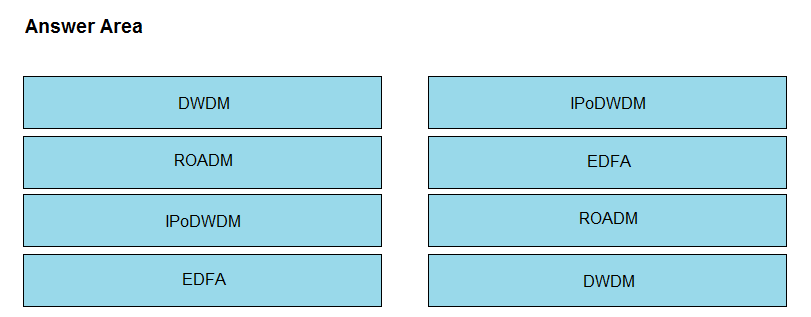Cisco® 350-501 Exam Practice Questions (P. 2)
- Full Access (480 questions)
- One Year of Premium Access
- Access to one million comments
- Seamless ChatGPT Integration
- Ability to download PDF files
- Anki Flashcard files for revision
- No Captcha & No AdSense
- Advanced Exam Configuration
Question #11
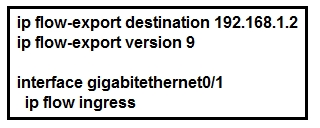
Refer to the exhibits. Which information is provided for traceback analysis when this configuration is applied?
- Asource interfaceMost Voted
- Bpacket size distribution
- CIP sub flow cache
- DBGP version
Correct Answer:
C
C
send
light_mode
delete
Question #12
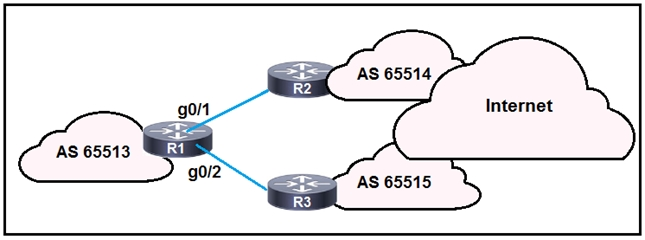
Refer to the exhibit. R1 is connected to two service providers and is under a DDoS attack.
Which statement about this design is true if URPF in strict mode is configured on both interfaces?
- AR1 drops all traffic that ingresses either interface that has a FIB entry that exits a different interface.Most Voted
- BR1 drops destination addresses that are routed to a null interface on the router.
- CR1 permits asymmetric routing as long as the AS-PATH attribute entry matches the connected AS.
- DR1 accepts source addresses on interface gigabitethernet0/1 that are private addresses.
Correct Answer:
A
A
send
light_mode
delete
Question #13

Refer to the exhibit. Router 1 was experiencing a DDoS attack that was traced to interface gigabitethernet0/1.
Which statement about this configuration is true?
- ARouter 1 accepts all traffic that ingresses and egresses interface gigabitethernet0/1.
- BRouter 1 drops all traffic that ingresses interface gigabitethernet0/1 that has a FIB entry that exits a different interface.
- CRouter 1 accepts source addresses that have a match in the FIB that indicates it is reachable through a real interface.
- DRouter 1 accepts source addresses on interface gigabitethernet0/1 that are private addresses.
Correct Answer:
C
Reference:
https://www.cisco.com/c/en/us/td/docs/switches/datacenter/sw/4_1/nx-os/security/configuration/guide/sec_nx-os-cfg/sec_urpf.html
C
Reference:
https://www.cisco.com/c/en/us/td/docs/switches/datacenter/sw/4_1/nx-os/security/configuration/guide/sec_nx-os-cfg/sec_urpf.html
send
light_mode
delete
Question #14
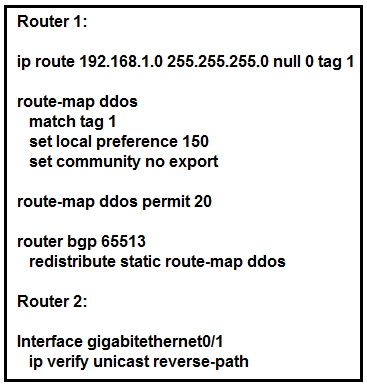
Refer to the exhibit. An engineer is preparing to implement data plane security configuration.
Which statement about this configuration is true?
- ARouter 2 is the router receiving the DDoS attack.
- BRouter 1 must be configured with uRPF for the RTBH implementation to be effective.
- CRouter 1 is the trigger router in a RTBH implementation.Most Voted
- DRouter 2 must configure a route to null 0 for network 192.168.1.0/24 for the RTBH implementation to be complete.
Correct Answer:
C
C
send
light_mode
delete
Question #15
Which configuration modifies Local Packet Transport Services hardware policies?
A.
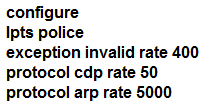
B.
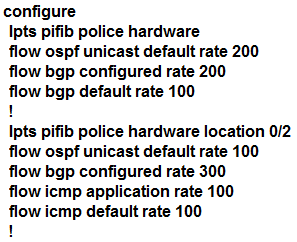
C.
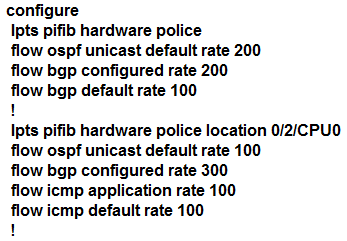
D.
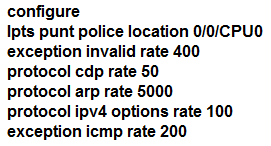
A.

B.

C.

D.

Correct Answer:
C
Reference:
https://www.cisco.com/c/en/us/td/docs/routers/crs/software/crs_r4-1/addr_serv/command/reference/b_ipaddr_cr41crs/ b_ipaddr_cr41crs_chapter_0111.html#wp1754734006
C
Reference:
https://www.cisco.com/c/en/us/td/docs/routers/crs/software/crs_r4-1/addr_serv/command/reference/b_ipaddr_cr41crs/ b_ipaddr_cr41crs_chapter_0111.html#wp1754734006
send
light_mode
delete
Question #16
Which additional feature does MPLS DiffServ tunneling support?
- Amatching EXP and DSCP values
- BPHB layer management
- Cusing GRE tunnels to hide markings
- Dinteraction between MPLS and IGP
Correct Answer:
B
Reference:
https://www.cisco.com/c/en/us/td/docs/ios-xml/ios/mp_te_diffserv/configuration/15-mt/mp-te-diffserv-15-mt-book/mp-diffserv-tun-mode.html
B
Reference:
https://www.cisco.com/c/en/us/td/docs/ios-xml/ios/mp_te_diffserv/configuration/15-mt/mp-te-diffserv-15-mt-book/mp-diffserv-tun-mode.html
send
light_mode
delete
Question #17
You are creating new Cisco MPLS TE tunnels. Which type of RSVP message does the headend router send to reserve bandwidth on the path to the tailend router?
- Apath
- Btear
- Cerror
- Dreservation
Correct Answer:
A
Reference:
https://packetpushers.net/rsvp-te-protocol-deep-dive/
A
Reference:
https://packetpushers.net/rsvp-te-protocol-deep-dive/
send
light_mode
delete
Question #18
Which statement describes the advantage of a Multi-Layer control plane?
- AIt provides multivendor configuration capabilities for Layer 3 to Layer 1.
- BIt automatically provisions, monitors, and manages traffic across Layer 0 to Layer 3.Most Voted
- CIt supports dynamic wavelength restoration in Layer 0.
- DIt minimizes human error configuring converged networks.
Correct Answer:
A
A
 GPT-4o - Answer
GPT-4o - Answer
The correct answer, A, highlights the Multi-Layer control plane's capability to provide multivendor configuration capabilities across multiple layers (Layer 3 to Layer 1). However, there seems to be a significant consensus among users suggesting that option C might also be a suitable answer, focusing on dynamic wavelength restoration at Layer 0. It's essential to verify the scope and settings of the Multi-Layer control planes discussed in specific training materials or Cisco documentation to ensure the accuracy of this topic coverage. This examination point definitely merits a review of concepts to confirm if one or both answers could apply under different scenarios.
send
light_mode
delete
Question #19
DRAG DROP -
Drag and drop the technologies from the left onto the correct definitions on the right.
Select and Place:
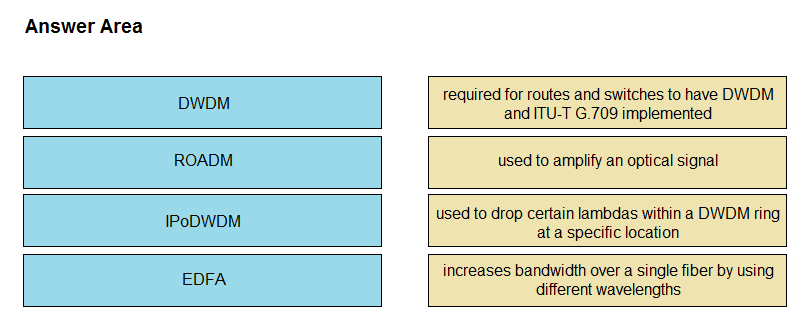
Drag and drop the technologies from the left onto the correct definitions on the right.
Select and Place:

send
light_mode
delete
Question #20
An engineer is setting up overlapping VPNs to allow VRF ABC and XYZ to communicate with VRF CENTRAL but wants to make sure that VRF ABC and XYZ cannot communicate.
Which configuration accomplishes these objectives?
A.
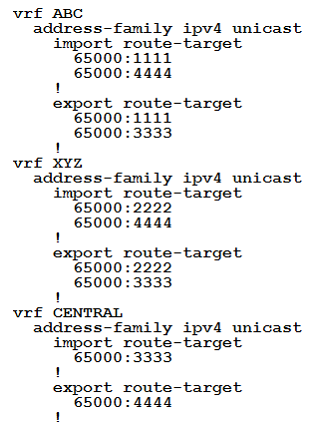
B.
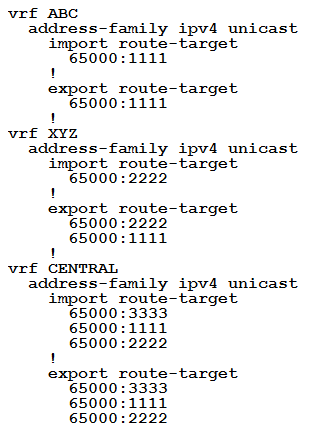
C.
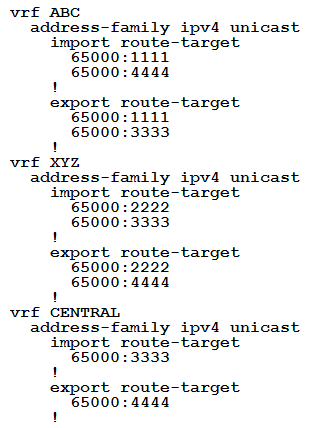
D.

Which configuration accomplishes these objectives?
A.

B.

C.

D.

send
light_mode
delete
All Pages

